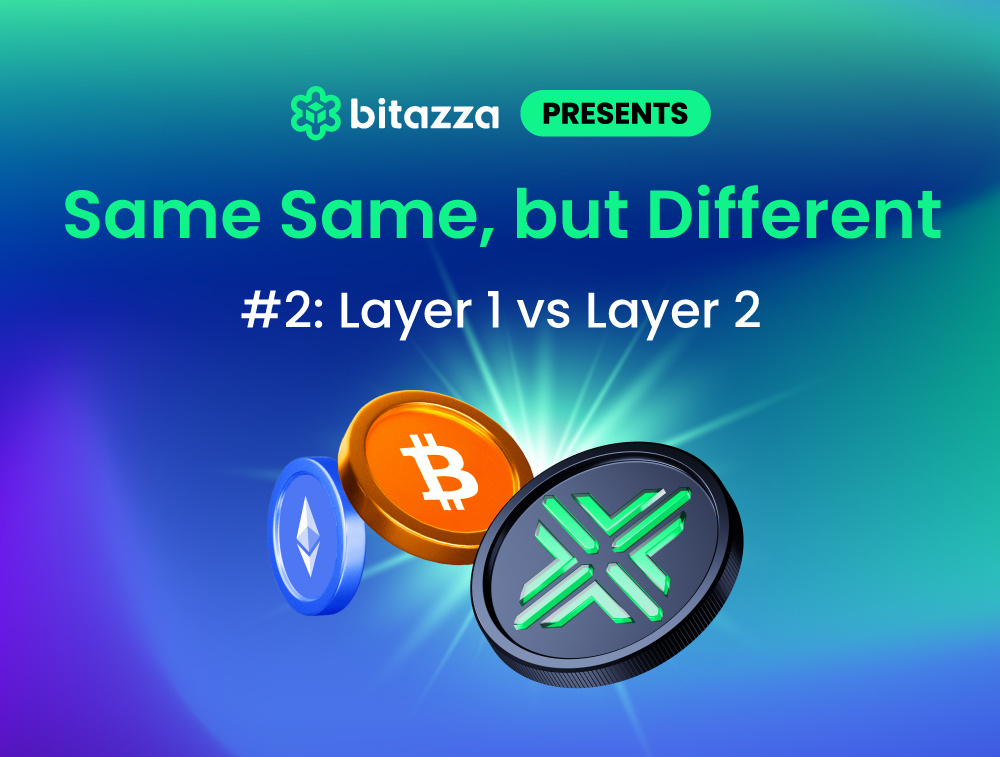Share this
Same Same, but Different #2: Layer 1 vs Layer 2

In the world of crypto and specifically with blockchain technology, you'll often hear terms like Layer 1 and Layer 2 thrown around. They both sound like they’re doing similar things—and in some ways, they are. They both process transactions on a blockchain and keep the network running smoothly.
But dig a little deeper and you’ll find they serve very different roles—especially when it comes to speed, cost, and scalability. So, let’s break it down. Same same, but different.
Layer 1 vs. Layer 2
Same Same: Both are blockchain technologies used for transactions.
Whether it’s Bitcoin, Ethereum, or Polygon, both Layer 1 and Layer 2 solutions are built to process and record transactions securely. They maintain trust through decentralization and cryptography—and they’re both essential parts of the Web3 ecosystem.
Different:
- Layer 1 (L1): The base blockchain layer (e.g. Bitcoin, Ethereum, Solana). It’s the core protocol.
- Layer 2 (L2): A scaling solution built on top of Layer 1 to handle transactions faster and cheaper (e.g. Polygon, Arbitrum, Optimism built on Ethereum).
For example, if Layer 1 is represented by a highway, then Layer 2 is the express lane or metro system built on top of the highway to ease congestion and allow people to get from point A to point B in a shorter time at a lower cost.
What is Layer 1?
Layer 1 refers to the main blockchain architecture. It's the foundation where blocks are added, consensus is maintained, and security is enforced.
- Examples: Bitcoin, Ethereum, Solana, BNB Chain
- Security: Handled by miners (Proof-of-Work) or validators (Proof-of-Stake)
- Cost & Speed: Often slow and expensive during high network activity
- Use Case: Base infrastructure for smart contracts, NFTs, dApps, and token transfers
Best For:
- Core network transactions
- Long-term store of value
- Use cases where maximum decentralization and security matter
What is Layer 2?
Layer 2 is a secondary framework built on top of a Layer 1 blockchain. It takes some of the workload off the base layer to process transactions more efficiently—before settling the results back to Layer 1.
- Examples: Polygon (on Ethereum), Arbitrum, Optimism, Lightning Network (on Bitcoin)
- Purpose: Scale the blockchain by making it faster and cheaper
- How it works: Processes transactions off-chain, then batches and submits them to Layer 1
- Benefits: Significantly lower gas fees, higher throughput
Best For:
- Daily transactions, micro-payments
- Users and dApps that need high speed and low fees
- Scaling Ethereum without compromising on decentralization
Key Differences at a Glance
|
Factor |
Layer 1 (L1) |
Layer 2 (L2) |
|
Role |
Base blockchain |
Scaling solution on top of Layer 1 |
|
Examples |
Bitcoin, Ethereum, Solana |
Polygon, Arbitrum, Optimism |
|
Speed |
Slower (congestion possible) |
Faster (offloads L1 traffic) |
|
Fees |
Higher gas/transaction fees |
Lower fees due to off-chain processing |
|
Security |
Native to the network |
Relies on Layer 1 for settlement/security |
|
Use Case |
Asset storage, core transactions |
dApps, DeFi, gaming, micro-payments |
|
Scalability |
Limited by design |
Specifically designed to scale L1 |
Which One Should You Use?
Use Layer 1 if you:
- Are transferring large amounts and need maximum security
- Are interacting directly with core smart contracts
- Prefer to pay a premium for base-layer reliability
Use Layer 2 if you:
- Want faster, cheaper transactions
- Are using dApps that support L2 (like DeFi or NFT platforms)
- Want to save on gas fees while interacting with Ethereum-based assets
Same Same, but Different — Use the Right Layer
Both Layer 1 and Layer 2 are essential pieces of the blockchain puzzle. They aren’t in competition—they complement each other. Layer 1 provides the infrastructure and decentralization, while Layer 2 brings speed, affordability, and scalability.
The key is to understand what you're trying to do—and pick the layer that makes the most sense for that action.
- Need to transfer a large amount securely? Use Layer 1.
- Want to mint an NFT or use DeFi fast and cheap? Use Layer 2.
Pro Tip: On Bitazza, you can interact with multiple blockchain networks—whether it's Layer 1 like Bitcoin and Ethereum, or tokens that support Layer 2 networks. Stay tuned as we continue to scale our platform to support even more seamless and affordable transactions.
Learn more about blockchain fundamentals and trading strategies on the Bitazza Blog: https://blog.bitazza.com/blog
Ready to explore Layer 1 and Layer 2 assets?
Download Bitazza here: https://bitazza.onelink.me/YsZ4/xua047tn
Share this
- Crypto 101 (75)
- Trading (60)
- Crypto Weekly (46)
- Educational (43)
- Bitazza 101 (41)
- Featured (11)
- Missions (8)
- Market (6)
- Bitazza Insight (5)
- Research (5)
- Derivatives (4)
- TradingView (4)
- Education (3)
- Futures Trading (3)
- Freedom Shards (1)
- Freedom Token (FDM) (1)
- Intermediate (1)
- Product and features (1)
- Tether (1)
- Tether (USDt) (1)
- crypto exchange (1)
- December 2025 (3)
- November 2025 (6)
- October 2025 (10)
- September 2025 (8)
- August 2025 (17)
- July 2025 (29)
- June 2025 (13)
- May 2025 (14)
- April 2025 (12)
- March 2025 (8)
- February 2025 (8)
- January 2025 (8)
- December 2024 (7)
- November 2024 (5)
- October 2024 (14)
- September 2024 (9)
- August 2024 (14)
- July 2024 (3)
- June 2024 (48)
No Comments Yet
Let us know what you think